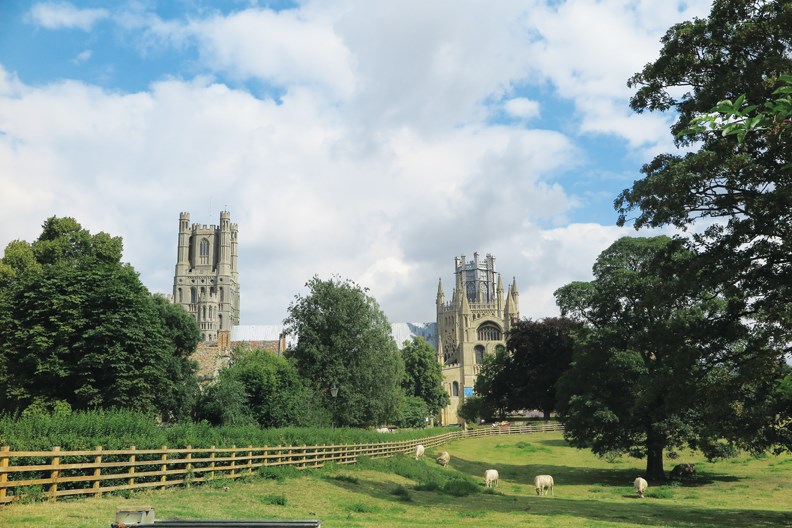When is a ship not a ship? The answer to this riddle is the Ship of the Fens, Ely Cathedral, whose nearly 70-metre tower surges up from the surrounding Fenland like a ship’s prow. It is the only building in the United Kingdom that is recognized as one of the Seven Medieval Wonders of the World. I first approached it from the Dean’s Meadow, which, although in the city centre, is still given to animals for grazing.
I had begun my exploration of Ely by following the Eel Trail from the banks of the River Great Ouse up through to the middle of the city. Ely is said to be named after the local eels that spend years in the Fens before swimming over 3,000 miles to the Sargasso Sea in the Atlantic to breed. Along the trail are featured public artworks such as eight stainless steel glaives, pitchfork-like tools for spearing the eels, a hive made of willow for catching eels, and a giant mosaic eel made of ancient pottery fragments.
Ely, Cambridgeshire, is the highest point in the Fens, the Holy Land of the English. At 2.75 metres below sea level, it is the lowest land in the United Kingdom. The Fens were so marshy in the olden days that workers wore stilts to harvest reeds and sedge from the fields. Despite the resistance of the Fen workers, the fields were drained by Dutch engineers at the end of the 17th century. As the land drained and the peat shrunk, the fields sunk to lower than the surrounding waterways, which only constant pumping keeps from overflowing. Since 2003, the Great Fen Project has been reflooding fields to establish pre-agricultural nature reserves. It is a unique countryside best viewed from the nearly 70-metre West Tower of Ely Cathedral, well worth the 288-step climb.
Ely Cathedral’s more famous tower is the Octagon Tower, a wonder of medieval engineering, shaped like a lantern and constructed to replace a Norman tower that collapsed in 1322. My guided tour of the cathedral included both towers, and I was overawed as I crouched under the original rough-edged tower beams made of eight huge oaks, to look down 50 metres into the nave. Another cathedral highlight is the free-standing 14th-century Lady Chapel, wonderfully lit by its tall windows. Along the walls of this vast space are innumerable niches of intricately detailed statues, the heads or faces of which were all hacked off during the Reformation. The cathedral is popular as a film site and was used, for example, in The King’s Speech. Also not to be missed is the cathedral stained glass museum with its examples of stained glass from the 14th century to present day and featuring many works by women.
Oliver Cromwell lived in Ely with his family for about 10 years beginning in 1636, and his house, now a museum, makes for a fascinating tour. A highlight was the kitchen, dating from 1205, with its table of model foods from Cromwell’s time. I took home free excerpts from The Court and Kitchen of Elizabeth Cromwell, which was published in 1664 during the English Restoration to vilify her for being such a plain and frugal housekeeper. I do not expect to try out the recipe for eel pie, but the one for sack posset, a kind of egg and cream custard, sounds quite tasty. Puritan Oliver Cromwell, the man who banned Christmas, instituted the Penal Laws against Irish Catholics and confiscated their land in Ireland, and even beheaded a king, remains controversial. The museum presents all sides to his story and gives credit to his wife’s accomplishments.
The Ely Museum is located in the old Bishop’s Goal, a 13th-century building. Inspiring was an exhibit about the Ely and Littleport Riots of 1816, in which men and women joined together to protest high prices and low wages.
Ely has always been famous for its markets and fairs. The word “tawdry” derives from the cheap St. Audrey’s lace necklaces sold at the medieval fair in Ely. However, the days of tawdry are over, and best browsing and shopping is at the Babylon Gallery, named after the Babylon Pottery made from local clay since post-medieval times. I stayed at the Peacock Bed and Breakfast and Tea Room, which is furnished with antiques and welcomed me as soon as I walked in with a cup of tea and delicious baked goods. I had lunch in the Cathedral Refectory and dinner at Le Spice. Ely is easily reached by train, bus or car. My airfares were arranged by a Sunshine Coast travel agency. To find out more about life on the Fens, read Mary Chamberlain’s oral history, Fenwomen: A Portrait of Women in an English Village.



